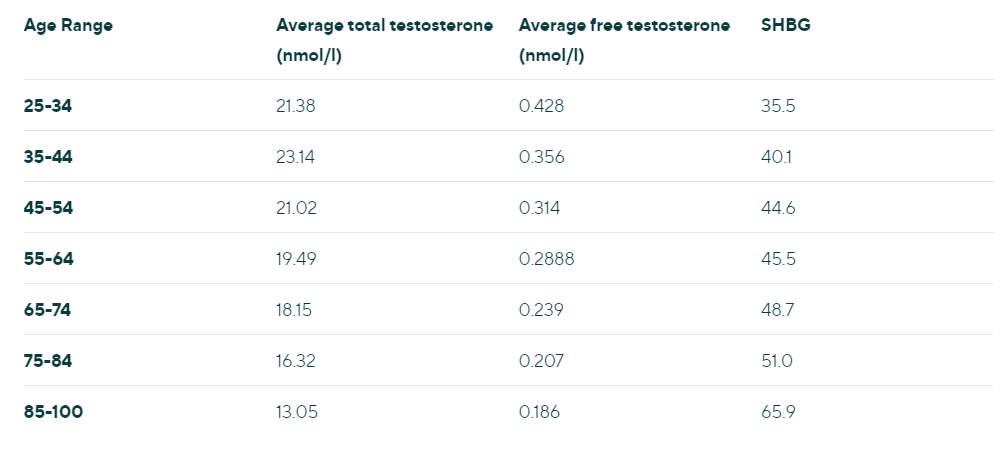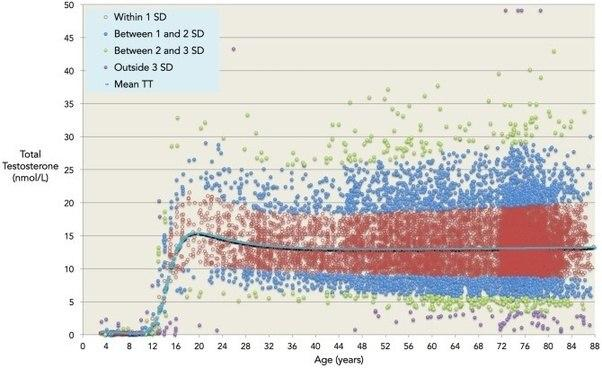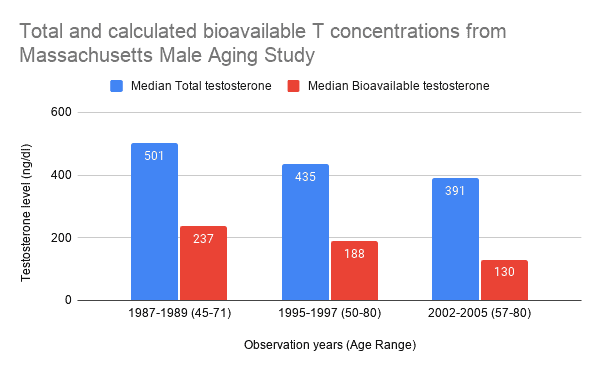
We tend to think of testosterone as the essence of manliness. While not strictly true – and low testosterone certainly doesn’t make you any less of a man – it does control many male attributes. It is important for sperm production, body composition, facial hair, and sex drive.
Sadly, men’s testosterone levels have dropped 20% in the last 20 years. This is worrisome as we need to produce healthy amounts of testosterone to maintain our vitality and overall good health. But what is considered ‘normal’ testosterone levels in men?
Here we explain the amount of testosterone you need to be at your peak physical, mental and sexual health. This article also uncovers how testosterone levels can be measured, how they fluctuate with age, and the current problems with the methods used to deduce the ‘normal’ testosterone range.
What are Normal Testosterone Levels?
All men are different, and there is no precise measurement of testosterone you ‘should’ have. Testosterone levels fluctuate from man to man, throughout the day, and as you age.
That said, healthy testosterone levels are considered to fall within the range of 7.6 and 31.4 nmol/L. This refers to the total amount of testosterone in your bloodstream. You may come across total testosterone measurements expressed in ng/dL. These are the US units – when using these measurements, the healthy range is around 270 to 1070 ng/dL.
You can also measure your free testosterone in the bloodstream. Some testosterone binds to proteins in circulation to help transport and distribute it around the body. Total testosterone refers to both bound and unbound testosterone, whereas free testosterone is a measure of the unbound hormone only. Healthy levels of free testosterone are considered 0.3 nmol/L or greater.
How is Testosterone Measured?
Testosterone levels are measured through a blood test. The male sex hormone uses the bloodstream to travel around the body, so blood tests provide an accurate representation of the amount of testosterone in your system. You can take a finger prick test at home, or a nurse or doctor can take your blood sample from a vein.
When measuring testosterone, you need to take your blood test at around 9am. This is because your testosterone levels are highest in the morning and can drop by 10 to 20% throughout the day. The variation partially depends on your age, with testosterone levels in older men generally fluctuating less than in younger men.
After collecting your blood sample, it is analysed in a laboratory. Your doctor will measure both total and free testosterone levels, as well as other related hormones and proteins. These come back on a form with the male testosterone levels attached (see below).

If you find these values confusing, don’t worry! The main information to take away is the figures for ‘testosterone’ (total testosterone) and ‘free testosterone’.
In the above example, this man had ‘normal’ total testosterone levels yet low free testosterone levels. This illustrates why it’s crucial not to rely solely on total testosterone measurements for a complete picture of your hormonal health. It can be a great indicator of low testosterone, but it doesn’t always reveal the complete picture.
How do Testosterone Levels Change With Age?
Your testosterone levels aren’t stable throughout your lifetime. They start low at birth before peaking in your late teens. Testosterone levels then stay at this high level for around ten years. However, once you reach the age of 30, your testosterone levels naturally start to decline gradually.
According to research, total testosterone falls by around 1.6% on average per year, while free testosterone drops by 2 to 3% per year (Mohr et al. 2005; Zirkin and Tenover 2012).
Here is a look at the average male testosterone levels for different age groups:

Source: Vermeulen, A. (1996). Declining Androgens with Age: An Overview. In Vermeulen, A. & Oddens, & B.J. (Eds.), Androgens and the Aging Male (pp. 3-14). New York: Parthenon Publishing.
These results show a reduction in total and free testosterone levels with age and increased SHBG (sex hormone binding globulin). SHBG is the protein testosterone binds to in the blood. Higher levels of this protein mean there is less free (unbound) testosterone – just one of the reasons that free testosterone drops so much with age.
How are ‘Normal’ Testosterone Levels Determined?
‘Normal’ values listed on laboratory reports are based on the testosterone levels found in studies of male populations. Most of the research is on men aged 20 to 80 (who aren’t necessarily free from low testosterone symptoms). They also include men with illnesses and varying degrees of stress/environmental factors.
Researchers then take the results from this group of men – from different age groups and states of health – and put the results into a graph. A percentage of the top and bottom 5% of values are removed (using statistical analysis) and you are left with the ‘normal’ male testosterone levels/values.
The graph below demonstrates how the reference ranges are calculated using standard deviations. Note that it has completely different ‘average’ testosterone levels from what we see in other studies. The red and blue areas combine to produce the range of ‘normal’ testosterone levels.

What is the Problem with ‘Normal’ Male Testosterone Levels?
Knowing the average range of testosterone is useful for diagnosing low testosterone in men, but calculating the ‘normal’ range using the above method is flawed.
The ‘normal’ testosterone range is not based on when men get symptoms – it’s based on statistical analysis. The top 5% of men at the top and bottom of the range are excluded as they’re deemed ‘too high’ or ‘too low’. Therefore, the ‘normal’ range refers to the 90% of men in the middle range.
The problem with this method is that labs are only looking at the highest to lowest levels of all men in a population to determine what’s ‘normal’ and what isn’t; they haven’t correlated this with whether the men in that population are experiencing low testosterone symptoms.
If doctors look purely at these ranges, they ignore the fact that some men experience low testosterone symptoms at higher levels of testosterone.
Why are Men’s Testosterone Levels Dropping?
As you can see in the graph below, the average testosterone level in the population is dropping every decade. There are many reasons for this reduction in male hormone levels, from obesity to environmental chemical exposure.

As a result of falling testosterone levels, you’d expect more men to be diagnosed with low testosterone. But in fact, the rates of men being treated for this condition have increased but are not in line with the drop we see in overall levels.
Unfortunately, it remains difficult for the medical community to become comfortable with diagnosing and treating this growing issue. There are complex reasons behind this. These range from poor knowledge and understanding of the condition to stigma around testosterone itself, to the use of inaccurate normal male testosterone levels in laboratory results.
For example, many men with low testosterone are treated with anti-depression medication (SSRIs) instead of treating the real cause of their mental health issues. These medications may even reduce testosterone production further, exacerbating the condition. Other men have been told they are “too muscley” to have low testosterone, stemming from a misunderstanding of what testosterone does.
The result is that many men are being denied treatment despite having low levels of testosterone.
How Can We Improve the Diagnosis of Low Testosterone?
Testosterone blood tests and ‘normal’ ranges provide a great indication of whether or not you have low testosterone and whether TRT is the best solution for your symptoms. However, hormonal health is far more complex than a black-or-white test result.
The first thing to ensure an accurate diagnosis is to get your total and free testosterone levels tested. Unfortunately, the test for free testosterone isn’t as cheap or easy to attain (or as well known), so it is often neglected by doctors. This is often the case when getting your levels checked on the NHS.
It is a good idea to measure several other essential biomarkers, too. For example, the BSSM (British Society of Sexual Medicine) suggests that men with a raised LH (luteinising hormone – a hormone that stimulates the testicles to produce testosterone) should be considered for TRT. We’ve also already mentioned the importance of SHBG on testosterone levels.
Not only do these values provide a better look into your current health status, but they also help doctors choose the best treatment option for your situation. The best way to get measurements for all essential biomarkers is to get tested through a private health service like MANUAL.
Key Takeways
While helpful in some ways, ‘normal’ testosterone levels can be misleading. A man who had very high testosterone levels when a younger man may have genuine and devastating symptoms but fall within the healthy range given by labs. The average doctor will tell him that his levels are completely normal when his blood results come back within range.
Similarly, a young man aged 25 years may feel fatigued and depressed at a testosterone level similar to that of an 80-year-old. But based on the ranges provided by the labs, he will be considered ‘normal’. He will be struggling with the symptoms of low testosterone and will probably be put on SSRIs to attempt to treat his depression and anxiety.
This is why doctors should use a combination of total testosterone and free testosterone levels as well as symptoms to assess whether a man is likely to suffer from low testosterone. We need more studies to establish likely symptomatic ranges for men, and laboratories need to base their ranges on research rather than a statistical analysis of populations.






